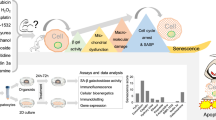Abstract
Tumour necrosis factor α (TNFα) is a pleiotropic cytokine that is produced mainly by monocytes and macrophages. TNFα appears to be responsible for many of the inflammatory and necrotic changes seen in malignant or infectious liver diseases. In addition, blood levels of TNFα have been reported to be elevated in those with hepatic diseases. Although TNFα is synthesized mainly by monocytes and macrophages, its production has recently been found in non-haemopoietic cells as well. Therefore we have used the human liver cell line HepG2 to test for the inducible production of TNFα in hepatic parenchymal cells. No constitutive TNFα gene expression was detected by quantitative reverse transcriptase-polymerase chain reaction (RT-PCR). However, treatment with the proinflammatory cytokine interleukin 1β (IL-1β) or phorbol 12-myristate-acetate (PMA) led to a marked increase in TNFα mRNA levels. Maximal TNFα mRNA levels were observed after 3-h incubation periods, decreased thereafter and became undetectable after 12 h. The culture supernatant from cells treated with IL-lβ or PMA contained significant amounts of TNFα protein which was immunologically detectable and biologically active. We believe that our report of inducible TNFα production in this widely available hepatic cell line adds a valuable tool for understanding TNFα gene expression in nonhaematopoietic cells.
Similar content being viewed by others
References
Banerjee R, Karpen S, Siekevitz M, Lengyel G, Bauer J, Acs G (1989) Tumor necrosis factor-a induces a kB sequence-specific DNA-binding protein in human hepatoblastoma HepG2 cells. Hepatology 10:1008–1013
Beutler B (1995) TNF, immunity and inflammatory disease: lessons of the past decade. J Invest Med 43:227–235
Carswell EA, Old LJ, Kassel RL, Green S, Fiore N, Williamson B (1975) An endotoxin-induced serum factor that causes necrosis of tumors. Proc Natl Acad Sci USA 72:3666–3670
Chomczynski P, Sacchi N (1987) Single-step method of RNA isolation by acid guanidinium thiocyanate-phenol-chloroform extraction. Anal Biochem 162:156–159
Chung IY, Kwon J, Benveniste EN (1992) Role of protein kinase C activity in tumor necrosis factor-a gene expression. J Immunol 149:3894–3902
Fandrey J, Huwiler A, Frede S, Pfeilschifter J, Jelkmann W (1994) Distinct signaling pathways mediate phorbol-ester-induced and cytokine-induced inhibition of erythropoietin gene expression. Eur J Biochem 226:335–340
González-Amaro R, Garcia-Monzón C, Garcia-Buey L, Moreno-Otero R, Alonso JL, Yagüe E, Pivel JP, López-Cabrera M, Fernández-Ruiz E, Sánchez-Madrid F (1994) Induction of tumor necrosis factor a production by human hepatocytes in chronic viral hepatitis. J Exp Med 179:841–848
Han J, Brown T, Beutler B (1990) Endotoxin-responsive sequences control cachectin/ tumor necrosis factor biosynthesis at the translational level. J Exp Med 171:465–475
Herkens C, Wolff M, Fandrey J, Schuler F, Jelkmann W (1993) Immunocytochemical demonstration of erythropoietin in hypoxic human hepatoma cultures. Histochemistry 100:303–309
Jelkmann W, Pagel H, Wolff M, Fandrey J (1991) Monokines inhibiting erythropoietin production in human hepatoma cultures and in isolated perfused rat kidneys. Life Sci 50: 301–308
Kelly J, Darlington GJ (1989) Modulation of the liver specific phenotype in the human hepatoblastoma line Hep G2. In Vitro Cell DevBiol 25:217–222
Köck A, Schwarz T, Kirnbauer R, Urbanski A, Perry P, Ansel JC, Luger TA (1990) Human keratinocytes are a source for tumor necrosis factor α: evidence for synthesis and release upon stimulation with endotoxin or ultraviolet light. J Exp Med 172:1609–1614
Kramer SM, Carver ME (1986) Serum-free in vitro bioassay for the detection of tumor necrosis factor. J Immunol Methods 93:201–206
Meyer M, Schreck R, Baeuerle PA (1993) H2O2 and antioxi-dants have opposite effects on activation of NF-κB and AP-1 in intact cells: AP-1 as secondary antioxidant-responsive factor. EMBO J 12:2005–2015
Perlmutter DH, Dinarello CA, Punsal PI, Cotten HR (1986) Cachectin/tumor necrosis factor regulates hepatic acute-phase gene expression. J Clin Invest 78:1349–1354
Rubin BY, Anderson SL, Sullivan SA, Williamson BD, Carswell EA, Old LJ (1986) Nonhematopoietic cells celected for resistance to tumor necrosis factor produce tumor necrosis factor. J Exp Med 164:1350–1355
Shakhov AN, Collart MA, Vassalli P, Nedospasov SA, Jongeneel CV (1990) KB-type enhancers are involved in lipopolysaccharide-mediated transcriptional activation of the tumor necrosis factor α gene in primary macrophages. J Exp Med 171:35–47
Siebert PD, Larrick JW (1992) Competitive PCR. Nature 359:557–558
Spriggs D, Imamura K, Rodriguez C, Horiguchi J, Kufe DW (1987) Induction of tumor necrosis factor expression and resistance in a human breast tumor cell line. Proc Natl Acad Sci USA 84:6563–6566
Tracey KJ, Cerami A (1994) Tumor necrosis factor: a pleiotropic cytokine and therapeutic target. Annu Rev Med 45:491–503
Tracey KJ, Wei H, Manogue KR, Fong Y, Hesse DG, Nguyen HT, Kuo GC, Beutler B, Cotran RS, Cerami A, Lowry SF (1988) Cachectin/tumor necrosis factor induces cachexia, anemia, and inflammation. J Exp Med 167:1211–1227
Wolff M, Jelkmann W (1993) Effects of chemotherapeutic and immunosuppressive drugs on the production of erythropoietin in human hepatoma cultures. Ann Hematol 66:27–31
Author information
Authors and Affiliations
Rights and permissions
About this article
Cite this article
Frede, S., Fandrey, J. & Jelkmann, W. Interleukin 1β and phorbol ester induce tumour necrosis factor α production in a hepatic cell line (HepG2). Pflügers Arch. 431, 923–927 (1996). https://doi.org/10.1007/s004240050086
Received:
Revised:
Accepted:
Issue Date:
DOI: https://doi.org/10.1007/s004240050086




